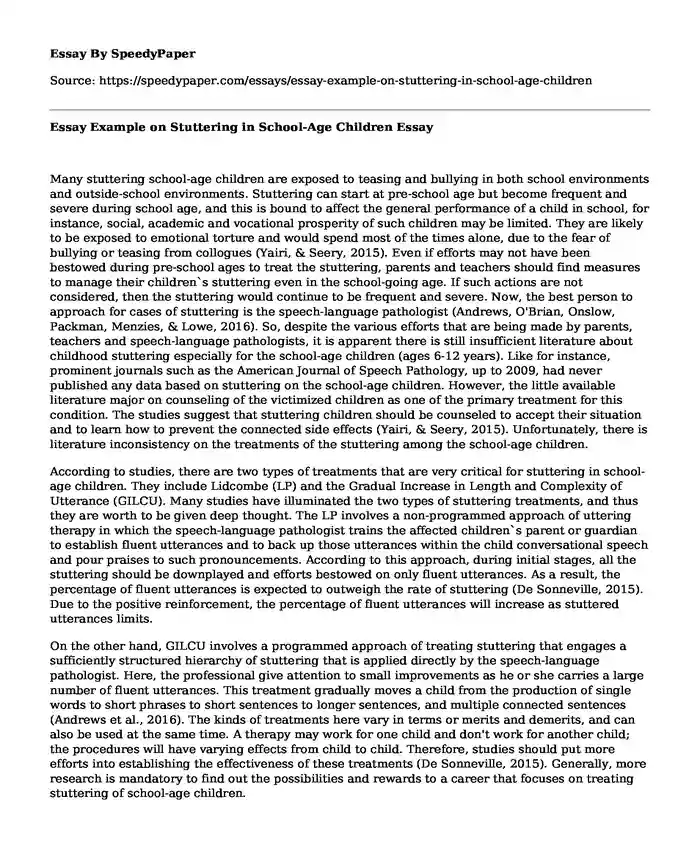
| Type of paper: | Essay |
| Categories: | Health and Social Care School Child development |
| Pages: | 3 |
| Wordcount: | 646 words |
Many stuttering school-age children are exposed to teasing and bullying in both school environments and outside-school environments. Stuttering can start at pre-school age but become frequent and severe during school age, and this is bound to affect the general performance of a child in school, for instance, social, academic and vocational prosperity of such children may be limited. They are likely to be exposed to emotional torture and would spend most of the times alone, due to the fear of bullying or teasing from collogues (Yairi, & Seery, 2015). Even if efforts may not have been bestowed during pre-school ages to treat the stuttering, parents and teachers should find measures to manage their children`s stuttering even in the school-going age. If such actions are not considered, then the stuttering would continue to be frequent and severe. Now, the best person to approach for cases of stuttering is the speech-language pathologist (Andrews, O'Brian, Onslow, Packman, Menzies, & Lowe, 2016). So, despite the various efforts that are being made by parents, teachers and speech-language pathologists, it is apparent there is still insufficient literature about childhood stuttering especially for the school-age children (ages 6-12 years). Like for instance, prominent journals such as the American Journal of Speech Pathology, up to 2009, had never published any data based on stuttering on the school-age children. However, the little available literature major on counseling of the victimized children as one of the primary treatment for this condition. The studies suggest that stuttering children should be counseled to accept their situation and to learn how to prevent the connected side effects (Yairi, & Seery, 2015). Unfortunately, there is literature inconsistency on the treatments of the stuttering among the school-age children.
According to studies, there are two types of treatments that are very critical for stuttering in school-age children. They include Lidcombe (LP) and the Gradual Increase in Length and Complexity of Utterance (GILCU). Many studies have illuminated the two types of stuttering treatments, and thus they are worth to be given deep thought. The LP involves a non-programmed approach of uttering therapy in which the speech-language pathologist trains the affected children`s parent or guardian to establish fluent utterances and to back up those utterances within the child conversational speech and pour praises to such pronouncements. According to this approach, during initial stages, all the stuttering should be downplayed and efforts bestowed on only fluent utterances. As a result, the percentage of fluent utterances is expected to outweigh the rate of stuttering (De Sonneville, 2015). Due to the positive reinforcement, the percentage of fluent utterances will increase as stuttered utterances limits.
On the other hand, GILCU involves a programmed approach of treating stuttering that engages a sufficiently structured hierarchy of stuttering that is applied directly by the speech-language pathologist. Here, the professional give attention to small improvements as he or she carries a large number of fluent utterances. This treatment gradually moves a child from the production of single words to short phrases to short sentences to longer sentences, and multiple connected sentences (Andrews et al., 2016). The kinds of treatments here vary in terms or merits and demerits, and can also be used at the same time. A therapy may work for one child and don't work for another child; the procedures will have varying effects from child to child. Therefore, studies should put more efforts into establishing the effectiveness of these treatments (De Sonneville, 2015). Generally, more research is mandatory to find out the possibilities and rewards to a career that focuses on treating stuttering of school-age children.
References
Andrews, C., O'Brian, S., Onslow, M., Packman, A., Menzies, R., & Lowe, R. (2016). Phase II trial of a syllable-timed speech treatment for school-age children who stutter. Journal of Fluency Disorders, 48, 44-55.
De Sonneville, C. C. (2015). The impact and treatment of developmental stuttering.
Yairi, E., & Seery, C. H. (2015). Stuttering: Foundations and clinical applications. Upper Saddle River, NJ: Pearson.
Cite this page
Essay Example on Stuttering in School-Age Children. (2022, Dec 18). Retrieved from https://speedypaper.com/essays/essay-example-on-stuttering-in-school-age-children
Request Removal
If you are the original author of this essay and no longer wish to have it published on the SpeedyPaper website, please click below to request its removal:
- Essay Example on Nestle Company Research
- Essay Example on How Digital Revolution Benefits Art
- Psychology Paper Example - Applied Behavior Analysis on ASD
- Free Paper Example: Conflict/Negotiation Communication in a Public Setting
- Essay Example: Implementing Policies in the Healthcare Delivery System
- Tech Revolutionising Medical Care: Impact on Nursing - Essay Sample
- Essay Example on Science of Play: Play as Intervention, Play in Schools
Popular categories




